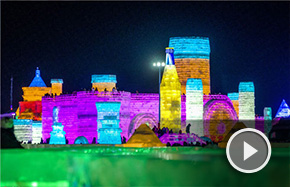Southern comfort
Guizhou is home to many different ethnic groups and locals are quick to offer a warm welcome
The former US ambassador to China used to tell journalists that Guizhou was the most beautiful place in the Middle Kingdom he had ever visited. Despite the ambassador's willing endorsement, the road to this part of the country is a path less traveled for many tourists.
Set in the heart of southwest China, Guizhou has some of China's finest scenery. It is also home to a large population of Miao people, many of who still follow their own rich cultural traditions.
A trip to Guiding, one the most beautiful counties in the province, is especially enticing for those who are curious about exotic cultures and who are suffering withdrawal symptoms from a lack of quality nature time.
Here, travelers can immerse themselves in a sea of rape plants, live with the local Bouyei people, take a rafting excursion along the Luobeihe River, pay a pilgrimage to the sacred mountain of Yangbao and have the time of their lives.
|
 The local Bouyei people have been living in Guiding county for centuries and continue practicing long-held traditions. Peng Nian / for China Daily
|
Here are five locations and activities worthy of consideration.
1. Golden Sea and the Snow White Mountain
This scenic spot, which lies just 13 kilometers to the southwest of Guiding county, is blanketed in a fetching combination of brilliant yellow rape flowers and snowy-white peach blossoms throughout March and April, hence the name.
In addition to its stunning vistas, the peak and its immediate environs offer visitors a unique opportunity to acquaint themselves with the exotic traditions and culture of the Bouyei people, the 11th largest of China's 56 ethnic minorities. There are more than 5,500 residents living in some 14 villages around the area and 95 percent of them are Bouyei people.
The region's cuisine extends to a tempting range of preserved fruits and piquant chili sauces.
2. Rafting on the Luobeihe River
The river has been officially designated as one of China's most scenic waterways and is the ideal means of leisurely enjoying the landscape of the region.

There is a deep sense of anticipation when you first board the raft. At first you are only aware of the river's relative tranquility, then, gradually, you tune into the sounds of the waterway - the steady trickle of the current, the sound of the water against the strokes of the paddle and the gently accompanying zephyrs that stir the passing woods.
Deer come to the water's edge to drink or watch as the raft silently drifts by. A squirrel scampers through the fallen leaves and up a tree. A stand of pines forms a circle around a small clearing like an outdoor chapel.
As an optional diversion, some visitors choose to stop off along the way. There is ample opportunity to stretch your legs and take in treats, such as the untended, natural woodland and any one of the 17 designated beauty spots that line the route.
There is the reward of tasting freshly caught and cooked river fish prepared to a recipe with a vintage of seven centuries that awaits at the end of the trip.
3. Scaling the Sacred Mountains
Some 10 km away from Guiding county the observant visitor can shade their eyes and focus on one of southwest China's three sacred mountains. Mount Yangbao, alongside Yunnan's Mount Jizu and Sichuan's Mount Emei, has been a revered Buddhist promontory since the time of the Ming Dynasty (1368-1644).
During its religious hey-day, the Lotus Temple, atop the peak, was home to more than 200 monks. The converse side of the mountain had a religious role, too and was the site of the Feifang Monastery. It is still celebrated today for its exquisite gardens. Suitably reverent visitors are free to peruse the 200 pagodas that house the remains of many of the holy men responsible for the site's botanical bounty.
The bohemian appeal of the setting saw it much favored by artists and writers throughout the years. Their abiding testaments to the beauty of the Mount and its immediate environs are now enshrined in a local museum, open to all culturally curious travelers.
4. Visiting the Gonggu township
At the ancient capital of Lanxun county visitors get the chance to view one of China's oldest extant city walls, built to ward-off would-be invaders and miscreants back in classical times. Construction of the city's defenses date back to the early days of the Ming Dynasty, when the 3 km long, 6-meter high wall provided the last impediment any impudent incomer.
Its success in securing the city is perhaps one reason why the contemporary sightseer can still enjoy some of the finest examples of traditional architecture. Many of the examples, such as the City God Temple, the Black God Temple, the Da Temple, the Guandi Temple and the eight nearby pavilions, are among the finest classically-styled buildings to be seen anywhere in the province.
5. Yunwu Lake
Yunwu literally means "a mountain shrouded in cloud and mist" and the mount that bears this exotic title certainly lives up to its billing. Mount Yunwu, part of the Miaoling range, is set 10 km to the south of Guiding county. It is the focal point of 30 sq km of unspoilt natural landscape, which includes the Pearl River and Yangzte River basins.
The sheer scale of its soaring peaks and deep valleys makes this something of an incongruous locale to be taking tea in, but this is just what the tradition demands. Yunwu tea has been the staple drink of the area since the days of the Qianlong emperor, back in the early years of the eighteenth century.
Back then, the region's tea was presented to the emperor's Beijing-based court and became a firm favorite among the royal household. A preserved stone tablet records the honor bestowed on the region's local brew and is an enduring testament to its popularity. Today its distinctive fishhook-shaped leaves, with their low-caffeine content, remain as popular as ever.




















